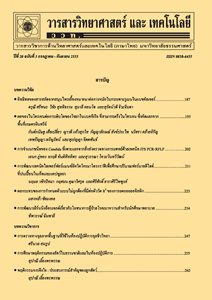Fire Emergency Evacuation Study Using Agent-based Computer Programming: A Case Study of Educational Building
Main Article Content
Abstract
In this research, we analyze the fire evacuation planning using the Pathfinder program, which is based on the agent-based simulation (ABS) approach. We conduct a designed experiment using a case study of a fire-emergency situation hypothetically occurred at the engineering building at Ubonratchathani university. Next, we analyze different egress/evacuation options for emergency evacuation planning, including stairway and elevator, by performing 6 designed cases to understand how these options affect travel time to an emergency exit on the first floor of building occupants. Then, we investigate agent behaviors and evacuation time of students and faculties assumed to randomly using various rooms in the building under 7 fire scenarios. Analyzed results show that various alternatives for evacuation planning affect both evacuation time and the number of people to be evacuated, which implies that proper plan for successful emergency preparedness and response, such as in an evacuation drill, should consider locations and severity of fire sources into account.
Article Details
References
International Federation of Red Cross and Red Crescent Societies, World Disaster Reports, Available Source: http://www.ifrc.org/publications-and-reports, August 25, 2016.
McLoughlin, D., 1985, A framework for integrated emergency management, Publ. Admin. Rev. 45: 165-172.
Thunderhead, Simulation Software for Science and Engineering: Manage Geo metry, Specify Parameters, Deliver Results, Available Source: http://www.thunderheadeng.com, August 25, 2016.
Ransikarbum, K. and Mason, S.J., 2016, Goal programming-based post-disaster decision making for integrated relief distribution and early-stage network restoration, Int. J. Prod. Econ. 182: 324-341.
Piraintorn, P. and Ransikarbum, K., 2018, Integrating geographic information system (GIS) in humanitarian relief logistics: Practical view point, pp. 1-7, 7th Asia Conference on Earthquake Engineering: Disaster Risk Reduction and Disaster Risk Management, Bangkok.
Ransikarbum, K. and Mason, S.J., 2016, Multiple-objective analysis of integrated relief supply and network restoration in humanitarian logistics operations, Int. J. Prod. Res. 54: 49-68.
Habib, M.S., Lee, Y.H., Memon, M.S., 2016, Mathematical models in humanitarian supply chain management: A systematic literature review, Math. Probl. Eng., Article ID 3212095.
Altay, N., Green, W.G., 2006, OR/MS research in disaster operations manage ment, Eur. J. Oper. Res. 175: 475-493.
Sheu, J.B., 2007, Challenges of emergency logistics management, Transp. Res. Part E Logist. Transp. Rev. 43: 655-659.
Tofighi, S., Torabi, S.A., Mansouri, S.A., 2016, Humanitarian logistics network design under mixed uncertainty, Eur. J. Oper. Res. 250: 239-250.
Wattanasang, N., Chantakot, W., Wisedla, K., and Ransikarbum, K., 2018, Simulation of fire smoke distribution in the electronics industry for automotive industry, pp., 1152-1156, Conference on Industrial Engineering (IE Network), Ubon Ratchathani.
Chantakot, W., Wattanasang, N., Wisedla, K. and Ransikarbum, K., 2018, Research agenda for simulation of fire escape with computer models in Thailand, pp. 1136-1141, Conference on Industrial Engineering Network (IE Network), Ubon Ratchathani.
CHantakot, W., Wattanasang, N., Wisedla, K. and Ransikarbum, K., 2018, Impact assessment using a computer model to study the leakage and explosion of LPG storage and distribution tanks of a separate type air conditioner factory, pp. 1157-1162, Conference on Industrial Network Engineering Conference (IE Network), Ubon Ratchathani.
Djanatliev, A., German, R, Kolominsky-Rabas, P. and Hofmann, B.M., 2012, Hybrid simulation with loosely coupled system dynamics and agent-based models for prospective health technology assess ments, Proceedings of the 2012 Winter Simulation Conference (WSC).
Shendarkar, A., Vasudevan, K., Lee, S. and
Son, Y., 2006, Crowd simulation for emergency response using BDI agent based on virtual reality, pp. 545-553, Proceedings of the 2006 Winter Simulation Conference (WSC).
Yodchan, K., 2014, Application of Simulation Programs for Fire and Migration Dynamics to Analyze the Evacuation Capacity on an Extra Large Building, Master Thesis, Kasetsart University, Bangkok.
Prasertpanij, S., 2012, Simulation of Fire Evacuation of High-rise Buildings with the Pathfinder Model: Case Study Q. House Lumpini Building, Master Thesis, Kasetsart University, Bangkok.
Wagner, N. and Agrawal, V., 2014, An agent-based simulation system for concert venue crowd evacuation modeling in the presence of a fire disaster, Exp. Syst. Appl. 41: 2807-2815.
Macal, C.M. and North, M.J., 2006, Tutorial on agent-based modeling and simulation part 2: How to model with agents, pp. 73-83, Proceedings of the 2006 Winter Simulation Conference (WSC).
Joo, J., Kim, N., Wysk, R.A., Rothrock, L., Son, Y. and Oh, Y., 2013, Agent-based simulation of affordance-based human behaviors in emergency evacuation, Simul. Mod. Pract. Theor. 32: 99-105.
Ronchi, E., Uriz, F.N., Criel, X. and Reilly, P., 2016, Modelling large-scale evacuation of music festivals, Case Stud. Fire Safety 5: 11-19.
Ronchi, E. and Nilsson, D., 2014, Assess ment of Total Evacuation Systems for Tall Buildings, Springer, New York.
Wang, H.R., Chen, Q.G., Yan, J.B., Yuan, Z. and Liang, D., 2014, Emergency guidance evacuation in fire scene based on pathfinder, pp. 226-230, 7th International Conference on Intelligent Computation Technology and Automation (IEEE).
Cuesta, A., Ronchi, E. and Gwynne, S.M., 2015, Collection and use of data from school egress trials, pp. 233-244, 6th International Symposium: Human Behavi our in Fire, Interscience Communications.
Ren, C., Yang, C. and Jin, S., 2009, Agent-based modeling and simulation on emergency evacuation, pp. 1451-1461, International Conference on Complex Sciences, Springer, Heidelberg.


